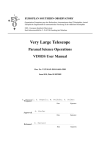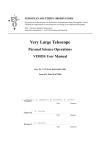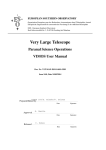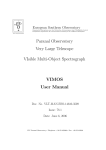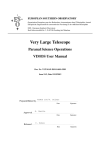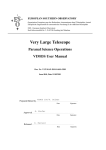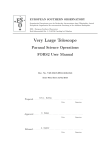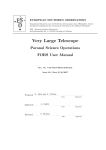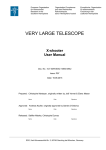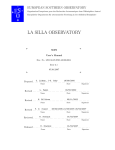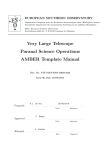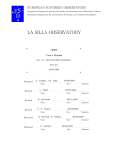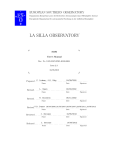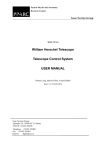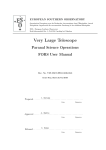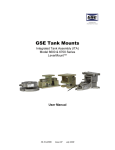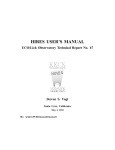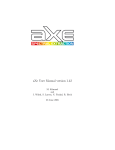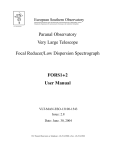Download VIMOS User Manual
Transcript
EUROPEAN SOUTHERN OBSERVATORY Organisation Européene pour des Recherches Astronomiques dans l’Hémisphère Austral Europäische Organisation für astronomische Forschung in der südlichen Hemisphäre ESO - European Southern Observatory Karl-Schwarzschild Str. 2, D-85748 Garching bei München Very Large Telescope Paranal Science Operations VIMOS User Manual Doc. No. VLT-MAN-ESO-14610-3509 Issue 79, Date 13/12/2006 G. Marconi, S. Bagnulo, M. Rejkuba Prepared . . . . . . . . . . . . . . . . . . . . . . . . . . . . . . . . . . . . . . . . . . Date Approved A. Kaufer . . . . . . . . . . . . . . . . . . . . . . . . . . . . . . . . . . . . . . . . . . Date Released Signature Signature O. Hainaut . . . . . . . . . . . . . . . . . . . . . . . . . . . . . . . . . . . . . . . . . . Date Signature VIMOS User Manual VLT-MAN-ESO-14610-3509 This page was intentionally left blank ii VIMOS User Manual VLT-MAN-ESO-14610-3509 iii Change Record Issue/Rev. Date draft 1.0 1.1 1.2 1.3 5.0 76.0 76.1 77.0 77.2 78.0 78.1 79.0 79.1 Section/Parag. affected Reason/Initiation/Documents/Remarks Oct 24, 2002 Feb 11, 2003 all all July 14 2003 Jan 12, 2004 Jun 14, 2004 Nov 26, 2004 Mar 21, 2005 June 30, 2005 all all all all 2.7; 3.5.7; 3.6.6; 3.7.7 2.1;2.2;2.3;2.6;3.4; 3.5;3.6;3.7;4.6 3.6.1, 3.7.2 Appendix none all front page and fonts Added clarifications about instrument FoV (Phase II) Draft delivered by VIRMOS Consortium first release for P71 (phase II) and P72 (Phase I) release for P72 (phase II) and P73 (Phase release for P73 (phase II) and P74 (Phase release for P74 (phase II) and P75 (Phase release for P75 (phase II) and P76 (Phase release for P76 (Phase I) Aug 31, 2005 Dec 01, 2005 Mar 01, 2006 Jun 06, 2006 Aug 23, 2006 Dec 13, 2006 release release release release release release for for for for for for P76 P77 P77 P78 P78 P79 (Phase (Phase (Phase (Phase (Phase (Phase II) I) II) I) II) I) release for P79 (Phase II) I) I) I) I) VIMOS User Manual VLT-MAN-ESO-14610-3509 This page was intentionally left blank iv VIMOS User Manual VLT-MAN-ESO-14610-3509 v Contents 1 Introduction 1.1 Scope . . . . . . . . . . . . . . . 1.2 More Information on VIMOS . . 1.3 Contact Information . . . . . . . 1.4 Period of Validity of this Manual 1.5 Version notes, change track . . . 1.5.1 Version 78.1 . . . . . . . . 1.5.2 Version 79.0 . . . . . . . . 1.5.3 Version 79.1 . . . . . . . . 1.6 Acknowledgments . . . . . . . . . . . . . . . . . . . . . . . . . . . . . . . . . . . . . . . . . . . . . . . . . . . . . . . . . . . . . . . . . . . . . . . . . . . . . . . . . . . . . . . . . . . . . . . . . . . . . . . . . . . . 2 Instrument Characteristics 2.1 Overview . . . . . . . . . . . . . . . . . . . . . . . . . 2.1.1 Instrument modes . . . . . . . . . . . . . . . . 2.2 Imaging . . . . . . . . . . . . . . . . . . . . . . . . . 2.2.1 IMG mode: orientation of the field of view . . 2.2.2 Image Quality . . . . . . . . . . . . . . . . . . 2.2.3 Imaging Filters . . . . . . . . . . . . . . . . . 2.3 Multi-Object Spectroscopy (MOS) . . . . . . . . . . . 2.3.1 Spectral range . . . . . . . . . . . . . . . . . . 2.3.2 Spectral resolution . . . . . . . . . . . . . . . 2.3.3 Multiplex characteristics . . . . . . . . . . . . 2.3.4 MOS mode: orientation of the field of view . . 2.4 Integral Field Unit (IFU) . . . . . . . . . . . . . . . . 2.4.1 IFU mode: orientation of the field of view . . 2.4.2 Fiber arrangement and spatial characteristics 2.4.3 Spectral range . . . . . . . . . . . . . . . . . . 2.4.4 Spectral resolution . . . . . . . . . . . . . . . 2.4.5 Multiplex characteristics . . . . . . . . . . . . 2.5 Detectors . . . . . . . . . . . . . . . . . . . . . . . . 2.5.1 Detector read-out modes . . . . . . . . . . . . 2.5.2 Controllers . . . . . . . . . . . . . . . . . . . . 2.5.3 Read-out noise and conversion factor . . . . . 2.5.4 Fringing . . . . . . . . . . . . . . . . . . . . . 2.5.5 Shutters . . . . . . . . . . . . . . . . . . . . . 2.5.6 More information . . . . . . . . . . . . . . . . 2.6 Calibration Units . . . . . . . . . . . . . . . . . . . . 2.7 Flexures . . . . . . . . . . . . . . . . . . . . . . . . . 3 Observing with VIMOS . . . . . . . . . . . . . . . . . . . . . . . . . . . . . . . . . . . . . . . . . . . . . . . . . . . . . . . . . . . . . . . . . . . . . . . . . . . . . . . . . . . . . . . . . . . . . . . . . . . . . . . . . . . . . . . . . . . . . . . . . . . . . . . . . . . . . . . . . . . . . . . . . . . . . . . . . . . . . . . . . . . . . . . . . . . . . . . . . . . . . . . . . . . . . . . . . . . . . . . . . . . . . . . . . . . . . . . . . . . . . . . . . . . . . . . . . . . . . . . . . . . . . . . . . . . . . . . . . . . . . . . . . . . . . . . . . . . . . . . . . . . . . . . . . . . . . . . . . . . . . . . . . . . . . . . . . . . . . . . . . . . . . . . . . . . . . . . . . . . . . . . . . . . . . . . . . . . . . . . . . . . . . . . . . . . . . . . . . . . . . . . . . . . . . . . . . . . . . . . . . . . . . . . . . . . . . . . . . . . . . . . . . . . . . . . . . . . . . . . . . . . . . . . . . . . . . . . . . . . . . . . . 1 1 1 1 1 2 2 2 2 2 . . . . . . . . . . . . . . . . . . . . . . . . . . 3 3 4 5 5 5 6 6 8 8 8 9 9 10 10 12 12 12 12 13 14 14 15 15 15 15 15 16 VIMOS User Manual VLT-MAN-ESO-14610-3509 3.1 Interaction with the telescope . . . . . . . . . . . . . . 3.1.1 Guide stars and Guidecam software tool . . . . 3.1.2 Guide Stars: Policy . . . . . . . . . . . . . . . . 3.1.3 Cumulative offsets . . . . . . . . . . . . . . . . 3.1.4 Telescope and Instrument Focus . . . . . . . . . 3.2 Atmospheric Dispersion . . . . . . . . . . . . . . . . . 3.3 Fringing and Flexures . . . . . . . . . . . . . . . . . . . 3.4 Imaging (IMG) . . . . . . . . . . . . . . . . . . . . . . 3.4.1 Pre-imaging . . . . . . . . . . . . . . . . . . . . 3.4.2 Science imaging . . . . . . . . . . . . . . . . . . 3.4.3 IMG mode: calibration plan . . . . . . . . . . . 3.4.4 IMG mode: pipeline . . . . . . . . . . . . . . . 3.4.5 IMG mode: Exposure Time Calculator . . . . . 3.5 Multi-Object Spectroscopy (MOS) . . . . . . . . . . . . 3.5.1 Pre-imaging . . . . . . . . . . . . . . . . . . . . 3.5.2 Rotator on sky . . . . . . . . . . . . . . . . . . 3.5.3 VIMOS Mask Preparation Software (VMMPS) . 3.5.4 Finding charts . . . . . . . . . . . . . . . . . . . 3.5.5 Visitors using MOS . . . . . . . . . . . . . . . . 3.5.6 MOS mode: grism+filter setup . . . . . . . . . 3.5.7 MOS mode: attached night time calibrations . . 3.5.8 MOS mode: calibration plan . . . . . . . . . . . 3.5.9 MOS mode: pipeline . . . . . . . . . . . . . . . 3.5.10 MOS mode: Exposure Time Calculator . . . . . 3.6 Integral Field Unit (IFU) . . . . . . . . . . . . . . . . . 3.6.1 Acquisition accuracy . . . . . . . . . . . . . . . 3.6.2 Dithering/jitter pattern . . . . . . . . . . . . . 3.6.3 IFU mode: grism + filter setup . . . . . . . . . 3.6.4 IFU mode: attached night time calibrations . . 3.6.5 IFU mode: calibration plan . . . . . . . . . . . 3.6.6 IFU mode: pipeline . . . . . . . . . . . . . . . . 3.6.7 IFU mode: Exposure Time Calculator . . . . . 3.7 VIMOS overheads . . . . . . . . . . . . . . . . . . . . . 4 VIMOS templates 4.1 Introduction . . . . . . . . . . 4.2 Template names . . . . . . . . 4.3 Things to know - Reminder . 4.4 List of templates . . . . . . . 4.5 Acquisition templates . . . . . 4.5.1 VIMOS img acq Preset . . . . . . . . . . . . . . . . . . . . . . . . . . . . . . . . . . . . . . . . . . . . . . . . . . . . . . . . . . . . . . . . . . . . . . . . . . . . . . . . . . . . vi . . . . . . . . . . . . . . . . . . . . . . . . . . . . . . . . . . . . . . . . . . . . . . . . . . . . . . . . . . . . . . . . . . . . . . . . . . . . . . . . . . . . . . . . . . . . . . . . . . . . . . . . . . . . . . . . . . . . . . . . . . . . . . . . . . . . . . . . . . . . . . . . . . . . . . . . . . . . . . . . . . . . . . . . . . . . . . . . . . . . . . . . . . . . . . . . . . . . . . . . . . . . . . . . . . . . . . . . . . . . . . . . . . . . . . . . . . . . . . . . . . . . . . . . . . . . . . . . . . . . . . . . . . . . . . . . . . . . . . . . . . . . . . . . . . . . . . . . . . . . . . . . . . . . . . . . . . . . . . . . . . . . . . . . . . . . . . . . . . . . . . . . . . . . . . . . . . . . . . . . . . . . . . . . . . . . . . . . . . . . . . . . . . . . . . . . . . . . . . . . . . . . . . . . . . . . . . . . . . . . . . . . . . . . . . . . . . . . . . . . . . . . . . . . . . . . . . . . . . . . . . . . . . . . . . . . . . . . . . . . . . . . . . . . . . . . . . . . . . . . . 16 16 18 18 18 18 19 20 20 21 21 21 21 21 21 22 22 22 24 24 24 24 24 25 25 25 25 25 26 26 26 27 27 . . . . . . 28 28 28 28 28 29 29 VIMOS User Manual VLT-MAN-ESO-14610-3509 4.5.2 VIMOS mos acq Mask . . . 4.5.3 VIMOS mos acq Standard . 4.5.4 VIMOS ifu acq Preset . . . 4.6 Science templates . . . . . . . . . . 4.6.1 VIMOS img obs Offset . . . 4.6.2 VIMOS mos obs Offset . . . 4.6.3 VIMOS ifu obs Offset . . . 4.7 Calibration Templates . . . . . . . 4.7.1 VIMOS img cal Photom . . 4.7.2 VIMOS img cal Astrom . . 4.7.3 VIMOS mos cal NightCalib 4.7.4 VIMOS mos cal Standard . 4.7.5 VIMOS ifu cal Specphot . . 4.7.6 VIMOS ifu cal NightCalib. . . . . . . . . . . . . . . . . . . . . . . . . . . . . . . . . . . . . . . . . . . . . . . . . . . . . . . . . . . . . . . . . . . . . . . . . . . . . . . . . . . . . . . . . . . . . . . . . . . . . . . . . . . . . . . . . . . . . . . . . . . . . . . . . . . . . . . . . . . . . . . . . . . . . . . . . . . . vii . . . . . . . . . . . . . . . . . . . . . . . . . . . . . . . . . . . . . . . . . . . . . . . . . . . . . . . . . . . . . . . . . . . . . . . . . . . . . . . . . . . . . . . . . . . . . . . . . . . . . . . . . . . . . . . . . . . . . . . . . . . . . . . . . . . . . . . . . . . . . . . . . . . . . . . . . . . . . . . . . . . . . . . . . . . . . . . . . . . . . . 31 32 33 35 35 36 37 39 39 39 40 40 41 42 A VIMOS Filters 43 B VIMOS Grisms 44 C Template Signature Files for Observation and Acquisition. C.1 Acquisition Templates . . . . . . . . . . . . . . . . . . . . . . . . . . . . . . . C.2 Observation Templates . . . . . . . . . . . . . . . . . . . . . . . . . . . . . . . C.3 Template Signature Files for Calibrations . . . . . . . . . . . . . . . . . . . . . 52 52 53 53 D Abbreviations and Acronyms 57 VIMOS User Manual 1 VLT-MAN-ESO-14610-3509 1 Introduction 1.1 Scope The VIMOS User’s Manual is intended to provide information on the following topics: • Overall description of the instrument (Sect. 2) • Observing with VIMOS (Sect. 3) • Observing and calibration templates (Sect. 4) 1.2 More Information on VIMOS All VIMOS Manuals are available on the VIMOS instrument WEB pages together with the most updated informations on the instrument: http://www.eso.org/instruments/vimos/ Information and software tools for the preparation of service and visitor mode observations with VIMOS are available at: http://www.eso.org/observing/p2pp/ServiceMode.html http://www.eso.org/observing/p2pp/VIMOS/VIMOS-P2PP.html In particular, information concerning mask preparation with VMMPS and guide star selection with Guidecam is given in the following additional manuals: VVMPS Guidecam Visiting astronomers will find further instructions on the Paranal Science Operations WEB page and the Paranal Observatory home page: http://www.eso.org/paranal/ http://www.eso.org/paranal/sciops/ 1.3 Contact Information In case of specific questions related to Service Mode observations and proposal preparation please contact the ESO User Support Department: [email protected] For visitor mode observations please contact the Paranal Science Operations Team: [email protected] 1.4 Period of Validity of this Manual This manual is valid for Phase II preparation of Period 79. VIMOS User Manual 1.5 VLT-MAN-ESO-14610-3509 2 Version notes, change track The first edition of this User Manual was delivered by the VIRMOS Consortium (P.I.: O. Le Fèvre). 1.5.1 Version 78.1 Version 78.1 contains more detailed and accurate information about the spectral range that can be observed in spectroscopic modes (MOS and IFU) with the various grisms. Table 11 has been updated. Hyperlinks have been added to the text. The various sections of the manual have been re-arranged. All changes by S. Bagnulo and M. Rejkuba, comments received by G. Marconi and L. Christensen. 1.5.2 Version 79.0 VIMOS manual has been ported to the standard format for VLT manuals. Changes by S. Bagnulo 1.5.3 Version 79.1 Substantial chances to the description of the instrument field of view. Changes by S. Bagnulo and M. Rejkuba. Dr. S.L. Morris is acknowledged for having improved Fig. 5. An error in Table 5 has been corrected. 1.6 Acknowledgments The following institutes have participated to the development of VIMOS: • Laboratoire d’Astrophysique de Marseille, Marseille, France • Observatoire de Haute-Provence, Saint-Michel l’Observatoire, France • Laboratoire d’Astrophysique de l’Observatoire Midi-Pyrénées, Toulouse, France • Osservatorio Astronomico di Capodimonte, Napoli, Italy • Istituto di Fisica Cosmica e Tecnologie Relative, Milano, Italy • Osservatorio Astronomico di Brera, Milano, Italy • Istituto di Radioastronomia, Bologna, Italy • Osservatorio Astronomico di Bologna, Bologna, Italy VIMOS User Manual VLT-MAN-ESO-14610-3509 3 Table 1: VIMOS opto-mechanical characteristics Instrument Location Opto-mechanical layout Wavelength coverage Detectors Spectral Resolution Filters Grisms Flexures Masks Multiplex Integral Field Unit Nasmyth B VLT-UT3 (Melipal) 4 beams, each a complete focal-reducer, F/1.88 output 0.37 to 1 microns 4 × 2048 × 4096, 15 µm/pixel R = 180 to 2500 (1 arcsec slit) 10 per channel, U’BVRIz, OS-red, OS-blue, GG435, GG475, 170mm diameter 6 per channel, LR red, LR blue, MR, HR blue, HR orange, HR red [1] Passive compensation, motion of ± 2 pixels over 3600 rotation 15 masks simultaneously loaded in instrument at maximum (per channel) [2] . Slits of any position and shape, width > 0.600 , length < 30”. 840 simultaneous slits, 10” long at R = 200 210 simultaneous slits, 10” long at R = 2000-2500 5400 × 5400 field, 6400 fibers with 0.6700 sampling 2700 × 2700 field, 6400 fibers with 0.3300 sampling [1] From October 2005, a set of four new and more efficient HR red VPHG grisms is installed and available in the 4 channels. [2] Some restrictions apply in operations; currently the number of masks that can be mounted at the instrument cabinet is 8. Please refer to the VIMOS web pages for updates. 2 2.1 Instrument Characteristics Overview VIMOS is the Visible Multi-Object Spectrograph for the Very Large Telescope (VLT) of the European Southern Observatory (ESO). This instrument has been built to provide the ESO community with a wide field spectrograph with high throughput and multiplex, dedicated to deep surveys. VIMOS operates in the 0.37–1.0 µm domain in three main observing modes: direct imaging (IMG), multi-slit spectroscopy (MOS), and integral field spectroscopy (IFU). Because of the large field of view, VIMOS optical path is split into four channels. The four quadrants of the instrument are operated in parallel (i.e., it is not possible to mix modes or filters or grisms between quadrants). The field of view of the four channels is 4 × 70 × 80 in IMG and MOS and up to 5400 × 5400 in IFU mode in low resolution spectroscopy. It provides an image scale of 0.205”/pixel in MOS and 0.67”/resolution element in IFU mode. Each of the 4 channels has a 2048 × 4096 pixels EEV CCD, with the 4k pixels being used along the dispersion to maximize the spectral coverage. VIMOS is installed on the Nasmyth B focus of UT3 (Melipal). The VIMOS mechanical and optical characteristics are summarized in Table 1. A schematic opto-mechanical layout is shown in Fig. 1. VIMOS User Manual VLT-MAN-ESO-14610-3509 4 Figure 1: VIMOS Opto-Mechanical layout • The focal plane is divided in 4 identical channels and is equipped with: the mask exchange units (MEU) which host up to 15 pre-punched masks for MOS spectroscopy per quadrant; the IFU fiber-head, and the IFU masks. • The folding mirror section hosts the four folding mirrors and the flexure compensators. • The Filter/Camera Section: the beam section hosts optical analyzers (filters and/or grisms), the camera, and the exposure shutter in front of the CCD. • FEU: the filter exchange units (one for each channel) are located below the main body of the instrument below the Filter/Camera Section; each unit hosts a juke-box of 10 filters permanently mounted. • GEU: the grism exchange units are located below the Filter/Camera Section; they host a carousel of six grisms permanently mounted. 2.1.1 Instrument modes VIMOS offers the following modes for observations: • Imaging (IMG) (see Sect. 2.2) • Multi-Object Spectroscopy (MOS) (see Sect. 2.3) • Integral Field Spectroscopy (IFU) (see Sect. 2.4) IMG mode uses broadband filters U’BVRIz. MOS and IFU modes share the set of grisms and order sorting filters given in Table 3. In MOS mode, a set of four laser punched masks VIMOS User Manual VLT-MAN-ESO-14610-3509 5 Table 2: VIMOS Imaging characteristics and performance Field of view Pixel scale Image Quality Filters F-ratio Limiting Magnitudes in 1h 4×70 × 80 separated by 2’ gaps illuminated CCD area: 2048 × 2350 pix2 slightly vignetted on the corners outside 8’ 0.205”/pixel 80 % encircled energy in 0.4” within the whole field U 0 , Bessel BVRI, Gunn z (see section A) 1.88 V=27.7 I=26.6 5σ detection for a point source V=26.5 I=25.4 5σ detection in 3” for a galaxy made of INVAR is inserted in the focal plane. In IFU mode, fibers are arranged along pseudoslits in the so-called “IFU masks”. IFU masks may be inserted in the instrument focal plane (in the same position as occupied by the INVAR masks in the MOS mode). The spectral characteristics of the two spectroscopic modes are therefore similar, but not identical. 2.2 Imaging Direct imaging is used to produce wide field images (VIMOS is the largest imager on the VLT) using broad band filters. This mode has two functions: produce science images, and produce the mandatory pre-images needed to prepare masks (see Sect. 3). Table 2 summarizes the main characteristics of the imaging mode. 2.2.1 IMG mode: orientation of the field of view Figure 2 shows the orientation of the instrument field of view. At 0◦ rotator angle the x axes of the CCDs are oriented E and the y axes are oriented N (top panels). Increasing rotator angle moves the compass counterclockwise. At 90◦ rotator angle the x axes are oriented S and the y axes are oriented E (bottom panels). Note that position angle increases as rotator angle. Figure 3 shows the instrument FoV keeping fixed the detectors with x axes increasing to the right, and y axes increasing to the top. Top right panels refer to the situation with the rotator at 0◦ , and bottom right panels refer to the situation with rotator at 90◦ . The corresponding positions of the detectors on sky are shown in the left panels. The gap between the quadrants is approximately 2’. The pointing coordinates correspond approximately to the center of the gap. 2.2.2 Image Quality For the most updated information please have a look at the Quality Control and Data Flow Operations Web pages. The focal plane of VIMOS is not strictly flat because of the complexity of the optical elements involved. This results in slight focus variations across the field, which translates in a variable PSF from the center to the periphery. The sky concentration effects are in any case small and negligible for flat-field and photometric calibrations. VIMOS User Manual VLT-MAN-ESO-14610-3509 6 Figure 2: Orientation of the VIMOS field of view on sky for position angles 0◦ and 90◦ , in IMG and MOS mode. 2.2.3 Imaging Filters VIMOS provides positions for 10 broadband filters in any of the four channels. Presently installed filters inside the instruments are U 0 , Bessel BVRI, Gunn z, and some order separation filters. Only the U’BVRIz filters are available for imaging programmes. The special U 0 is not a standard Bessel filter (see Figure 14). With the Bessel I and Gunn z filters the CCDs show fringes of approximately 7 %. The complete list of filters together with the transmission curves are presented in Appendix A (see Table 16, and Figs. 14 to 17). ESO will not accept requests for user’s supplied filters for VIMOS. 2.3 Multi-Object Spectroscopy (MOS) A variety of grisms with different wavelength ranges and dispersions is available in MOS mode. Order separating filters are available to eliminate the overlap, for a given slit, between orders 1 (the order used for science) and order 2 (always present on the detector). This is done by restricting the wavelength range of a particular grism to less than one octave in wavelength. The 0th order contamination is present only in multi-layered mode, i.e., when observing with the LR and the MR grisms. Table 3 indicates the recommended and allowed grism + filter combinations. Any other combinations of grisms and filters should be requested with a waiver. Defining in the OBs combinations not allowed and for which a waiver was not requested will result in these OBs being rejected by the User Support Department. ESO will not accept requests for user’s supplied grisms or filters for VIMOS. VIMOS User Manual VLT-MAN-ESO-14610-3509 7 Figure 3: A comparison of the orientation of the VIMOS field of view as seen on sky (left panels) and on detector (right panels) for position angles 0◦ and 90◦ , in IMG and MOS mode. VIMOS User Manual VLT-MAN-ESO-14610-3509 8 Table 3: Standard grism / filter combinations for MOS and IFU modes Grism Default LR blue OS-blue LR red OS-red MR GG475 HR blue Free HR red GG475 HR orange GG435 1 Filter Allowed Free Free OS-red, OS-blue1 – – – The grism-filter configuration MR+OS-blue is not supported by the pipeline Transmission curves are available in Appendix A for the filters, and Appendix B for the grisms. Table 4 shows the spectral range covered in MOS modes by the various grisms, as obtained by the automatic pipeline when reducing the spectrophotometric standard star. This spectral range is valid for slits close to the center of the field. 2.3.1 Spectral range In MOS mode, slits can be positioned at any position in the imaging field of view. With high-resolution grisms, the observed spectral range changes slightly according to the position of the slit. Table 5 shows the spectral ranges covered by the detector for each grism (and default order sorting filter) for the slits located at three different positions in the field of view. With low resolution grisms, the spectral coverage is independent of the position of the slit. 2.3.2 Spectral resolution The spectral resolution obtained with a 1” slit width with the various grisms is given in Table 4. 2.3.3 Multiplex characteristics A particular feature of the MOS mode is the possibility of stacking multiple layers of slits along the dispersion direction. This is only possible with the low resolution grisms (up to four slits along the dispersion direction) and the intermediate resolution grisms (up to two slits), for which the spectra are short enough (in number of pixels) to allow stacking. With the high-resolution grisms, only one slit can be placed along the dispersion direction. However, please note that in the multi-layer mode there is some order overlap: the second order of one slit may overlap with the first order of the adjacent slit. There is also 0th order contamination between different layers of slits. For faint objects, order overlap is usually not a problem: only the sky will contribute significantly to the overlap, with a contribution that cannot be distinguished from the first order. This however constrains the positioning of the slits in the focal plane: stacked slits along the dispersion direction have to be strictly parallel and of the same length to allow the second orders to overlap nicely with the first order of the adjacent slits. With the low-resolution grisms, the use of no filter instead of the default order sorting filters OS-blue and OS-red will result in longer spectra and second order overlap. It is strongly rec- VIMOS User Manual VLT-MAN-ESO-14610-3509 9 Table 4: MOS: spectral resolution and spectral ranges observed using the mask for spectrophotometric standard stars Grism LR blue LR red MR MR HR blue HR orange HR red4 1 2 3 4 Default Order sorting filter OS-Blue OS-Red GG475 OS red Free GG435 GG475 Spectral range 370-670 nm 550-950 nm 480-1000 nm 550-970 nm 415-620 nm1 520-760 nm2 630-870 nm3 Number of pixels 550 550 2000 2000 4096 4096 4096 Spectral Res. (1” slit) 180 210 580 580 2050 2150 2500 Dispersion (Å/ pixel) 5.3 7.3 2.5 2.5 0.51 0.6 0.6 Spectral multiplex 4 4 2 2 1 1 1 With HR blue grism the spectral range in quadrant 1(for a standard star) is 400-620 nm With HR orange grism the spectral range in quadrant 1 (for a standard star) is 505-745 nm With HR red grisms the spectral range in quadrant 1 (for a standard star) is 650-865 nm New HR red VPHG grisms have been installed from October 5, 2005. Table 5: Spectral coverage ∆λ for three positions of the slit in field of view (MOS mode) Grism LR red LR blue MR HR blue HR red HR orange Order sorting filter OS-red OS-blue GG475 Free GG475 GG435 ∆λ CCD center 550 - 950 nm 360 - 670 nm 500 - 1000 nm 415 - 620 nm 630 - 870 nm 520 - 760 nm ∆λ CCD bottom 550 - 950 nm 360 - 670 nm 500 - 1000 nm 468 - 674 nm 690 - 930 nm 577 - 817 nm ∆λ CCD top 550 - 950 nm 360 - 670 nm 500 - 950 nm 370 - 566 nm 570 - 805 nm 463 - 703 nm ommended to reduce the multiplex/number of slits along the dispersion direction to avoid/reduce multiple overlaps. The multiplex can be reduced by increasing the distance between slits. 2.3.4 MOS mode: orientation of the field of view The orientation of the instrument field of view in MOS mode can be inferred from Figs. 2 and 3, taking into account that not tilted slits are oriented along the x-axes, and that wavelength dispersion is along the y axis, with wavelength increasing with y. 2.4 Integral Field Unit (IFU) The Integral Field Unit (IFU) is a dedicated opto-mechanical system aimed at producing spectra of a contiguous area of up to 54 × 54 arcsec2 . The sky image is projected onto a micro-lens array with a choice of two spatial samplings (magnifications): 0.33” or 0.67” per resolution element (fibre). Each 2D input micro-lens is coupled to an optical fiber. The output of the fibers is re-arranged on a linear set of micro-lenses to produce an entrance slit to the spectrograph, at the mask focal plane location. Each IFU mask (one for each channel of VIMOS User Manual VLT-MAN-ESO-14610-3509 10 Figure 4: Orientation of the VIMOS IFU field of view on sky for position angles 0◦ and 90◦ , in IFU mode. VIMOS) has a set of 4 fibre-slits (or pseudo-slits), for a total of 6400 fibers. 2.4.1 IFU mode: orientation of the field of view Figure 4 shows the orientation of the instrument field of view in IFU mode for the four quadrants. On the detectors, wavelength dispersion is along the y axis, with wavelength increasing with y. The increasing position angle on the sky (east of north) corresponds to the positive rotator angle. Spatial characteristics are described in the Section below. As for IMG/MOS modes, the pointing coordinates in the header correspond to the center of the VIMOS field of view. Due to offset position of IFU with respect to the center, the relevant header keywords which contain the information of the pointing of the IFU are ”HIERARCH ESO TEL TARG ALPHA” and ”HIERARCH ESO TEL TARG DELTA”. 2.4.2 Fiber arrangement and spatial characteristics The special arrangement of fibers for VIMOS IFU head is shown in Fig. 5. The fibers numbering has been arranged following the scheme: mask - line - module -fiber (i.e. 4 - B - 5 - 67). The arrangement of the fibers into the 4 pseudo-slits mask (one for each channel) is reported in Fig. 6. The detailed IFU table is distributed to the users together with the data release. A masking-shutter (IFU shutter) is provided in front of the input micro-lens array; this allows the exclusive use of the central 1/4th of the field when IFU is used with intermediate and high spectral resolution grisms. In this configuration, only 1 fiber-slit per quadrant (mask) is used, for a total of 1600 fibers. The templates for IFU mode offer the option to insert a shutter to limit the field to the central part also for low resolution grisms. When small field can be accommodated, this avoids second order contamination by the sky or background objects from the 3 pseudo-slits corresponding to the outer part of the field of view. Table 6 shows the spatial characteristics of the IFU mode. VIMOS User Manual VLT-MAN-ESO-14610-3509 11 Figure 5: IFU head: details of the fiber modules. Low transmission fiber blocks are marked with white rectangles. For rotator angle = 0◦ , North is to the right, East to the top. Figure 6: IFU mode: fibers numbering on the masks VIMOS User Manual VLT-MAN-ESO-14610-3509 12 Table 6: Integral Field Unit: spatial characteristics Grism LR blue, LR red LR blue, LR red LR blue, LR red LR blue, LR red MR, HR blue, HR orange, HR red MR, HR blue, HR orange, HR red 2.4.3 Shutter OFF ON OFF ON ON ON Spatial sampling (arcsec/fibre) 0.67”/fibre 0.67”/fibre 0.33”/fibre 0.33”/fibre 0.67”/fibre 0.33”/fibre Field of view arcsec2 54” x 54” 27” x 27” 27” x 27” 13” x 13” 27” x 27” 13” x 13” Number of fibres 80 x 80 40 x 40 80 x 80 40 x 40 40 x 40 40 x 40 Pseudo-slits per quadrant 4 1 4 1 1 1 Spectral range Table 7 shows the spectral range covered in IFU modes by the various grisms, as obtained by the automatic pipeline when reducing the spectrophotometric standard star. With low and intermediate resolution grisms the spectral coverage is independent of the position of the IFU pseudo-slits. With the high-resolution grisms, the spectral coverage is determined also by the (fixed) positions of the pseudo-slits in the focal plane, but it varies slightly from quadrant to quadrant. The spectral coverage for each quadrant derived from the automatic reduction of standard star observations with VIMOS pipeline is listed in the Table 8. 2.4.4 Spectral resolution In IFU mode, spectral resolution is fixed by the combination grism + fiber size (the fiber FWHM is about 3.2 pixels, corresponding to 0.67”). The spectral resolution is about 1.25 times the spectral resolution obtained in MOS mode with a 1” slit width. The spectral resolution for various grism+filter combinations is given in Table 7. 2.4.5 Multiplex characteristics The same multiplex capability described in MOS mode is also used in IFU mode. With the low-resolution grisms there are 4 pseudo slits of fibers along the dispersion direction. With intermediate and high-resolution grisms only the central pseudo-slit is used (in practice by masking the entrance field of the IFU so that the other pseudo-slits do not receive sky light). 2.5 Detectors The detector mosaic of VIMOS consists of four 2k×4k EEV44 CCDs, thinned and back side illuminated. Table 9 indicates the basic characteristics of the VIMOS CCDs. Figure 7 shows the quantum efficiency curve of one of the CCDs. VIMOS User Manual VLT-MAN-ESO-14610-3509 13 Table 7: Spectral characteristics in IFU mode Grism LR blue LR red MR HR blue HR orange HR red Default Order sorting filter OS-Blue OS-Red GG475 None GG435 GG475 Spectral range common to all quadrants 400-670 nm 590-915 nm 490-1015 nm 415-620 nm 525-740 nm 645-870 nm Spectral Res. (1” slit) 220 260 720 2550 2650 3100 Dispersion (Å / pixel) 5.3 7.3 2.5 0.51 0.6 0.6 Spectral multiplex 4 4 1 1 1 1 Note: new HR red VPHG grisms have been installed fon October 5, 2005. Table 8: IFU: spectral coverage in the various quadrants Grism LR blue + OS blue LR red + OS red MR + GG475 HR blue + free HR orange + GG435 HR red + GG475 Q1 390 - 670 nm 570 - 915 nm 485 - 1015 nm 415 - 620 nm 525 - 745 nm 635 - 860 nm Q2 395 - 675 nm 580 - 930 nm 490 - 1020 nm 415 - 620 nm 525 - 745 nm 635 - 865 nm Q3 400 - 680 nm 590 - 930 nm 490 - 1020 nm 415 - 620 nm 525 - 745 nm 635 - 860 nm Q4 400 - 680 nm 585 - 930 nm 490 - 1015 nm 415 - 620 nm 525 - 740 nm 645 - 875 nm Table 9: Basic characteristics of the VIMOS CCDs Parameter Value Number of pixels 2048×4096 Pixel size (µm) 15 Dark current at –120◦ C (e− /px/h) <7 Deviation from Linearity (Full well; %) < 0.5 Charge transfer efficiency >0.999999 2.5.1 Detector read-out modes The CCDs have two read-out ports but only one is used. This increases the read-out time but, as a benefit, the gain, offset, and read-out noise are constant along the entire CCD. In spectroscopic mode, the full CCDs (2048×4096 pixels2 are read-out; in imaging mode, readout is windowed to 2048×2400 pixels2 . In fact, in both spectroscopic mode and in imaging mode, the CCDs are vignetted by some hardware. In spectroscopic mode, the illuminated area is about 1970×4096 pixels2 , and in imaging mode the illuminated area is about 1970×2300 pixels2 . The actual values depend on the individual CCDs. The default readout modes are indicated in Table 10. VIMOS User Manual VLT-MAN-ESO-14610-3509 14 Figure 7: QE curve of one VIMOS CCD Table 10: Detector Readout Modes and Characteristics VIMOS Mode Imaging Spectroscopy 2.5.2 Size Speed 4×2k×2k 225kpx s−1 4×2k×4k 225kpx s−1 Binning Gain Port Windowing Readout time 1×1 Low 1-port Not supported 1 m 1×1 High 1-port Not supported 1 m Controllers The 4 CCDs are controlled by two FIERA controllers. The detectors of channel 2 and 3 are controlled by FIERA A (VIMOSA), the detectors of channel 1 and 4 by FIERA B (VIMOSB). 2.5.3 Read-out noise and conversion factor Table 11 indicates the readout noise and gain values for the 4 chips. Note that these values are subject to change and are indicated here only for reference. Exact values have to be found in the image headers. Table 11: Detector read-out noise and conversion factors. For reference only, subject to change Chip CCD CCD CCD CCD CCD CCD CCD CCD 1 2 3 4 1 2 3 4 Read-out Mode RON [e− rms] K [e− /adu] 225 kpx s−1 , low gain (IMG mode) 5.3 1.70 −1 225 kpx s , low gain 5.2 1.86 225 kpx s−1 , low gain 5.3 1.95 −1 225 kpx s , low gain 4.9 1.80 −1 225 kpx s , high gain (MOS and IFU modes) 4.3 0.51 225 kpx s−1 , high gain 4.6 0.56 −1 225 kpx s , high gain 4.7 0.57 225 kpx s−1 , high gain 4.3 0.52 RON and conversion factor monitoring is available through the QC1 WEB pages VIMOS User Manual 2.5.4 VLT-MAN-ESO-14610-3509 15 Fringing With the z Gunn and Bessel I filters the fringing amplitude is around 7% in imaging and in spectroscopy the amplitude of fringing is of the order of 7-8% at maximum. Despite this relatively strong fringing, it is important to note that the structure is quite stable and dithered images taken in a sequence can easily remove the structure (see Sect. 3.3). 2.5.5 Shutters The shutter (one for each CCD camera) guarantees uniform illumination of the CCD to the 1 % level or better for exposure times as short as 1 sec (the shortest possible exposure time). 2.5.6 More information More (updated) information on detector characteristics, cosmetics, and performance on sky at: http://www.eso.org/projects/odt/ http://www.eso.org/observing/dfo/quality/ 2.6 Calibration Units VIMOS has three calibration units illuminating a calibration screen at the back of the Nasmyth shutter (closing the Nasmyth tunnel). Each unit has the following lamps: • Flatfield lamps: – QTH10 halogen lamp for imaging screen flats in VRIz, and MOS spectroscopic screen flats in LR red and blue – QTH50 halogen lamp for imaging screen flats in U’B, MOS screen flats in MR, HR red and blue, and all IFU screen flats • Arc lamps: – He – Ar – Ne The updated atlas of the spectral lines for the different grisms can be found at http://www.eso.org/instruments/vimos/inst/atlas/index.html 2.7 Flexures The passive flexure compensation of VIMOS is optimized to reach a reasonable compromise in every position of the Nasmyth rotator. An astatic compensator system is installed in quadrants 2, 3, and 4. Image motion due to instrument flexures under gravity are currently within ± 2 pixels for the four channels. See Sect. 3.3 for recommendations on how to deal with fringing and flexures. VIMOS User Manual 3 VLT-MAN-ESO-14610-3509 16 Observing with VIMOS All observations with VIMOS are done via “observing blocks” (OBs). OBs consist of one acquisition template including target information followed by “observing templates” related to the observing mode. The users will fill out the parameter fields (“keywords”) of the templates (e.g. grisms, filters, etc). All the preparations are done with the Phase II proposal preparation tool p2pp. In addition, VIMOS masks have to be prepared with the VIMOS mask manufacturing preparation software VVMPS. The strategy behind observing blocks and templates is to prepare the observations well in advance to minimize any interactive steps during the observations (optimization and service mode compatibility). The execution of the OBs will be mostly automatic and the execution will be done by telescope and instrument operators and staff astronomers. Direct interaction at execution time is only required for the target acquisition and to assess the quality of the data. The preparation of visitor and service mode observations requires special care, and the relevant documentation should be consulted. See Sect. 1 for instructions on how to retrieve the corresponding information. 3.1 3.1.1 Interaction with the telescope Guide stars and Guidecam software tool For telescope guiding and active optics correction it is necessary to find a guide star of magnitude in the range 11-13.5 within the Nasmyth field of view. The guide star is picked up by the Guide Probe, which is attached to the telescope adapter. (Note that the adapter is independent of the telescope rotator to which the instrument is attached.) In IMG and MOS mode, it is not always possible to find a guide star such that the Telescope Guide Probe is not vignetting the VIMOS field of view. Therefore, users are asked to select the guide star for their observations. The choice of the guide star is mandatory for pre-imaging, for imaging, and for MOS programs. In fact, the guide star for MOS is selected at the time of pre-imaging: guide star coordinates and position of guide probe (whether positive or negative) is stored in the pre-image headers, and subsequently propagated by VMMPS (see Sect. 3.5.3), the VIMOS Mask Preparation Software, into the Aperture Definition in Pixel (ADP) files. At the time of the MOS acquisition, this information is extracted from the ADP files and the same guide star as used for pre-imaging will be re-used for the MOS observations. Only in some exceptional cases, the telescope operator may have to select another guide star: see Sect. 3.1.2. Users need not select the guiding star for observations carried out in IFU mode. The position and the amount of the vignetting introduced in the field of view by the guide probe can be controlled with the help of the Guidecam software, that allows one to visualize the geometry of the VIMOS field of view and of the Telescope Guide Probe, and allows users to select the guide star most suitable to their observation. Figure 8 shows the Guidecam Graphical User Interface displaying the geometry of the VIMOS field of view and the Guide Probe at the Nasmyth focal plane of the telescope. VIMOS User Manual VLT-MAN-ESO-14610-3509 17 Figure 8: Guidecam Graphical User Interface. Superimposed to the field of view are the VIMOS field of view layout, Guide Probe drawing and USNO selected stars in the field. VIMOS User Manual 3.1.2 VLT-MAN-ESO-14610-3509 18 Guide Stars: Policy Starting from P72, ESO applies the following policy regarding guide stars: • Selection of a Guide Star for VIMOS observations is mandatory for MOS and IMG mode, to assess and control the amount and position of vignetting that may be introduced by the Guide Probe; see Phase 2 Web pages for detailed informations. • If no guide star is provided by the user (i.e. the option CATALOGUE of the Get Guide Star From P2PP parameter of the VIMOS ifu acq Preset template is selected), the guide star will be selected by the Telescope Operator at execution time. • If the user provides a guide star (by selecting the option SETUPFILE of the Get Guide Star From P2PP parameter of the VIMOS img acq Preset template), efforts will be made to use this guide star for imaging, pre-imaging and for the subsequent MOS observations, although this cannot be entirely guaranteed. Observing conditions (seeing, Moon, etc.) may indeed force to select a different guide star than the one selected by the user. In addition, it may happen that a guide star suitable for pre-imaging observations will not be usable for the spectroscopic follow-up if e.g. the seeing has changed. • It is requested that the users selecting a guide star for their observations use Guidecam to generate the finding chart to be delivered as part of their Phase II material. 3.1.3 Cumulative offsets For small telescope offsets, the telescope may keep the same guide star. However, observations involving cumulative offsets greater than about 30” often result in significant vignetting of the guide probe, or even in the loss of the guiding star. For these reasons, all dither positions for offset patterns used in the OBs must fit inside a 3000 × 3000 size box. If larger offsets are necessary, users need to prepare separate OBs and use appropriate guide star for each of them. 3.1.4 Telescope and Instrument Focus The telescope focus is automatically set by the active optics system. No intervention is required by the observer. Defocusing of the telescope is not possible during the observations. The instrument focus is corrected automatically for the different thickness of the various filters, and for temperature variations (autofocus). 3.2 Atmospheric Dispersion VIMOS is not equipped with Atmospheric Dispersion Corrector in none of its modes. The impact of atmospheric dispersion will be mostly noticed in MOS mode. In imaging, some image elongation may be noticed at high airmasses in the U or B band. In IFU, the effect will mostly be noticed with the LR blue grism and with the 0.3300 /fiber sampling. In MOS mode, the effects can lead to severe slit losses if some precautions are not taken. To minimize atmospheric dispersion effects at high airmass, and assuming that the observations are performed close to meridian, the slits need to be oriented N-S, forcing the rotator angle to be set at 90◦ . This rotator angle is the default one to be used for pre-imaging, and the same rotator angle will be used during spectroscopic follow-up. The VIMOS operational scenario VIMOS User Manual VLT-MAN-ESO-14610-3509 19 foresees to carry out MOS observations as close as possible to Meridian, within ± 2 hrs. Although this represents a major operational constraint, this is the only safe mode to ensure that slit losses are minimized in a systematic way for the blue setups, provided that slits are oriented N-S. More information and simulations can be found on the VIMOS web page. Figure 9 shows a worst case scenario of MOS observations with LR blue (spectral coverage 370 – 670 nm) for a field with declination +20◦ . Figure 9: Example of atmospheric dispersion at Paranal for a field at declination +20◦ , observed with the LR blue grism from ± 2 hrs from Meridian. The blue and red trails show the evolution of the blue and red wavelengths during the exposure. Atmospheric spectra start with N-E orientation and move to N-W through a N-S orientation while crossing the Meridian. The maximum amplitude of the dispersion is ∼ 2” at ± 2 hrs from Meridian. Slits clearly have to be oriented N-S as a default orientation to minimize the slit losses, assuming that all MOS observations will be carried out within ± 2 hrs from Meridian. 3.3 Fringing and Flexures The amount of flexures reported in Sect. 2.7 has a number of operational consequences: • The accuracy of the slit positions determined from pre-imaging depends on the rotator position. This is for the time being one of the reasons why slit widths narrower than 0.6” are not allowed. • Accuracy of sky subtraction / flat fielding: due to fringing at red wavelengths, accuracy of sky subtraction / flat fielding may be limited by flexures. With dithering / jittering VIMOS User Manual VLT-MAN-ESO-14610-3509 20 sequences, median running sky frames can be built in imaging or spectroscopy allowing accurate sky subtraction and/or flat fielding of the data • In spectroscopy, arcs and flats are taken during daytime and at constant rotator angle. Depending on the variation in rotator angle between daytime calibrations and night time observations, some flat field residuals and wavelength calibration offsets may be introduced due to the flexures. In order to minimize/eliminate these effects, night time calibrations can be taken with an adequate template (see Sect. 4). Attached flat and arc calibrations are mandatory for all IFU observations. Attached arcs are mandatory for MOS science observations with grisms LR blue and HR blue, and highly recommended for MOS science observations with grisms MR, HR red, HR orange, and HR red. Execution time is subtracted from the total allocated time. 3.4 Imaging (IMG) Imaging mode is used for both pre-imaging runs and science imaging runs. In both cases, users are requested to use Guidecam for the selection of guide stars. See Sect. 3.1.1 concerning Guidecam and Sect. 3.1.2 concerning the policy regarding Guide Stars. 3.4.1 Pre-imaging VIMOS pre-imaging is mandatory prior to MOS follow-up. Pre-imaging is carried out in service mode only. The following instructions for preparation of pre-imaging OBs should be strictly followed. Program ID It is mandatory for Phase I to request a specific pre-imaging run in the proposal form, and for Phase II to prepare the pre-imaging OBs by using the corresponding Program ID. Filter used The correction of the distortions is derived from R filter observations only. To minimize the slit losses due the distortion of the instrument, the use of the R filter for pre-imaging is mandatory. Pre-imaging with filters other than R may be requested with a waiver. Observation Category: PRE-IMAGE It is mandatory to set the Observation Category to PRE-IMAGE in the observation template VIMOS img obs Offset (see Sect. 4). Failure to do so will result in delays to process and deliver the pre-imaging data, and may result in MOS observations not being carried out. Rotator on sky The rotator on sky, otherwise called position angle on sky, cannot be freely selected by the user. This is in order to minimize the slit losses due to atmospheric dispersion (Sect. 3.2). The default value assigned to this parameter in P2PP should therefore not be modified. The default value is 90◦ , and corresponds to an orientation of the field with E to the top, N to the left (see Fig. 2). In special cases it may be possible to deviate from these rules if there is a valid scientific reason; in that case a waiver must be specifically requested to ESO before you submit your Phase II information. VIMOS User Manual VLT-MAN-ESO-14610-3509 21 Table 12: VIMOS Calibration Plan: IMG Mode Calibration Bias Darks Sky Flats Photom. Std. Photom. Std. high airmass Astrometric fields 3.4.2 Number 5 3 5 4 quadrants 1 quadrant Frequency Daily Monthly 3-7 days Daily Weekly When? Day time Day time Twilight time Night time Night time Products Master Bias Dark current Master Flat Zero Point Extinction coeff. Accuracy RON Comment 2% 5% 10% U’BVRIz U’BVRI U’BVRI 4 6 months Night time Distortion map 1 pixel R filter Science imaging Observation Category: SCIENCE It is mandatory to set the Observation Category to SCIENCE in the observation template VIMOS img obs Offset (see Sect. 4), otherwise data will be treated as pre-imaging and will not be processed as regular imaging data. Rotator on sky Users are encouraged, but not forced, to use the default value of the rotator angle, i.e., 90◦ . 3.4.3 IMG mode: calibration plan Table 12 indicates the nature, frequency and accuracy of VIMOS calibrations expected to be taken as part of the calibration plan. Only calibration frames required for the reduction of science data are reported. More calibrations will be taken by the operation staff for the purpose of maintaining and monitoring the instrument configuration and performance, e.g. mask to CCD transformations etc. These calibrations are not reported here. Calibration monitoring, including photometric zero points, can be found on the pages of the Quality Control group: http://www.eso.org/observing/dfo/quality/ 3.4.4 IMG mode: pipeline See http://www.eso.org/qc/pipeline-status.html for the information concerning the latest status of the ESO pipeline. 3.4.5 IMG mode: Exposure Time Calculator The approximate limiting magnitudes in direct imaging mode can be obtained from the exposure time calculator available on the ESO WEB pages http://www.eso.org/observing/etc/. 3.5 3.5.1 Multi-Object Spectroscopy (MOS) Pre-imaging Pre-imaging is mandatory for all MOS observations. Pre-imaging is carried out in service mode (see Sect. 3.4.1). VIMOS User Manual 3.5.2 VLT-MAN-ESO-14610-3509 22 Rotator on sky Because of the atmospheric dispersion effects (Sect. 3.2), the orientation on sky for MOS and pre-imaging observations is not a parameter set by the user, but is forced by the system to be 90◦ . All service and visitor mode users who have particular constraints for the orientation of their fields should request a waiver. 3.5.3 VIMOS Mask Preparation Software (VMMPS) The use of VMMPS (Sect. 3.5.3) is compulsory for the creation of the so-called ADP (Aperture Definition in Pixels) files which are subsequently loaded into p2pp when preparing Observation Blocks. ADP files will be used in Paranal to manufacture the masks. Here are some general features of VMMPS, for a quick reference guide. Consult the VIMOS web page for instructions to retrieve the package and the documentation. • VMMPS allows to define a mask in two situations: – From a contributed catalogue, consisting of list of targets with accurate relative astrometry (better than 0.3” rms). Input catalog is a list of RA-DEC coordinates. This catalogue needs to have, with the same relative astrometric accuracy, coordinates of bright objects / stars in the field of view. These objects / stars, after detection on the pre-images, will be used to register the target coordinates to the VIMOS coordinate reference frame. Some of these bright stars will be used as reference for acquisition. – From a catalog of target positions (in pixel coordinates) extracted from a VIMOS image. • VMMPS maximizes the number of slits that can be assigned to the targets in the input catalogue, in one or more masks, depending on user’s choice. • Upon realization of a first mask definition, VMMPS allows manual interaction to unselect targets, define curved slits, tilted slits, etc. However, note that manual modification of the mask definition should be done only by experienced users and with care. • VMMPS allows to define some objects as compulsory • VMMPS requires that some bright stars are defined as reference targets for acquisition purposes. Figure 10 shows the VMMPS Graphical User Interface. 3.5.4 Finding charts Finding charts for service mode OBs need to be prepared with VMMPS and show all targets with slits overplotted. VIMOS User Manual VLT-MAN-ESO-14610-3509 23 Figure 10: VMMPS Graphical User Interface: Example of ADP file superimposed to field of view VIMOS User Manual 3.5.5 VLT-MAN-ESO-14610-3509 24 Visitors using MOS Visitors using the MOS mode are requested to prepare Observation Blocks ahead of their scheduled visitor run, and upon completion of their pre-imaging observations (like in service mode). This is to guarantee that visitors will have a sufficient knowledge of the VIMOS Mask Preparation Software (VMMPS, Sect. 3.5.3) prior to their visit at Paranal, and to allow mask manufacturing ahead of time. Limited additional support is guaranteed for mask preparation on the mountain, up to 3 masks per night, to be prepared at least 48 hrs in advance. The instrument has a capacity of 15 masks (per quadrant) loaded simultaneously (one slot is normally occupied by a mask dedicated to observations of spectrophotometric standard stars). However, some restrictions may apply for technical reasons in the number of masks which can be hosted simultaneously into the cabinets. Until P77, only 8 masks can be simultaneously accommodated in the instrument cabinet (1 of which is the mandatory spectroscopic mask), and the same is currently foreseen for P78. Please refer to the Call for Proposals and to the instrument WEB pages for the updated status of the instrument situation. Note that masks cannot be exchanged at night. 3.5.6 MOS mode: grism+filter setup In MOS mode only one filter+grism combination per OB is permitted (the only filter exchange allowed is the one between acquisition and science template). Users who want to observe the same targets with different filter+grism combinations are requested to submit separate OBs for different filter+grism combinations and to consider the respective overheads. 3.5.7 MOS mode: attached night time calibrations To correct for instrument flexures, the use of attached nighttime arcs (see Sect. 3.5.8), is MANDATORY for all MOS OBs using LR blue and HR blue grisms, and strongly recommended for all setups. Users may also attach screen-flats. The execution time for these nighttime calibrations is always subtracted from the total allocated time. 3.5.8 MOS mode: calibration plan Table 13 indicates the nature, frequency and accuracy of VIMOS calibrations expected to be taken as part of the calibration plan. Only calibration frames required for the reduction of science data are reported. More calibrations will be taken by the operation staff for the purpose of maintaining and monitoring the instrument configuration and performance, e.g. mask to CCD transformations etc. These calibrations are not reported here. Calibration monitoring data can be found on the pages of the Quality Control group: http://www.eso.org/observing/dfo/quality/ 3.5.9 MOS mode: pipeline See http://www.eso.org/qc/pipeline-status.html for the information concerning the latest status of the ESO pipeline. VIMOS User Manual VLT-MAN-ESO-14610-3509 25 Table 13: VIMOS Calibration Plan: MOS Mode Calibration Bias Darks Screen Flats Screen Arcs Screen Arcs Number 5 3 5 1 1 Specphot. Standard Star 4 quadrants Frequency When? Daily Day time Monthly Day time Daily Day time Daily Day time Attached to science OB with HR or LR blue Daily Night time Products Master Bias Dark current MOS Flat Dispersion coeff. Dispersion coeff. Accuracy1 RON Comment 5% 0.3 pix 0.3 pix All used masks All used masks All used masks Response function 10% All grism+filter setups used 1 Internal accuracy, not considering instrument flexures (see Sect. 2.7). IMPORTANT NOTE The execution time for all attached night time calibrations (screen-flats and arcs) is subtracted from the total allocated time. 3.5.10 MOS mode: Exposure Time Calculator The approximate limiting magnitudes in MOS mode can be obtained from the exposure time calculator available on the ESO WEB pages http://www.eso.org/observing/etc/. 3.6 3.6.1 Integral Field Unit (IFU) Acquisition accuracy In IFU mode acquisition is “blind”, i.e., limited by the accuracy of the telescope pointing (∼ 300 accuracy). 3.6.2 Dithering/jitter pattern With the large field of view of the VIMOS-IFU, techniques equivalent to ”shift-and-add” classically used in imaging, are a possible mode of operations. Dithering/jitter pattern is a list of differential pointing positions around a central position. Several short images (with exposure times set to have sky background limited exposures) are taken at each position of a dithering pattern, which are combined to reconstruct an image with the total required exposure time. This allows to eliminate the sky contribution, cosmic rays, the CCD fringing (particularly strong in the red), cosmetic defects on the detectors, and to produce very accurate flat fielding for correction of pixel to pixel variations. The dithering pattern depends on the mean size of the observed objects: it should be larger than the mean size of the objects for the method to work efficiently. 3.6.3 IFU mode: grism + filter setup In IFU mode, only one filter+grism combination per OB is permitted. Users who want to observe the same targets with different filter+grism combinations are requested to submit separate OBs for different filter+grism combinations and to consider the respective overheads. VIMOS User Manual VLT-MAN-ESO-14610-3509 26 Table 14: VIMOS Calibration Plan: IFU Mode Calibration Bias Darks Screen Flats Number 5 3 3 Frequency Daily Monthly Daily When? Day time Day time Day time Screen Arc 1 Daily Day time Screen Flats 1 to 32 Screen Arcs 1 Specphot. Standard Star 4 quadrants Attached to all science OBs Attached to all science OBs Daily Night time Products Master Bias Dark current IFU Flat with HR Orange IFU Arc with HR Orange IFU Flat Accuracy1 RON Dispersion coeff. 0.3 pix Response function 10% Comment Monitoring Monitoring 5% All grism+filter setups used 1 Internal accuracy, not considering instrument flexures (see Sect. 2.7). With grism HR blue, 3 screen flats are always mandatory. IMPORTANT NOTE The execution time for all attached night time calibrations (screen-flats and arcs) is subtracted from the total allocated time. 2 3.6.4 IFU mode: attached night time calibrations To better take into account the effects of instrument flexure the use of attached nighttime calibrations, arcs and flats (see Sect. 3.6.5), is MANDATORY for all IFU OBs. This template will provide 1 or 3 flat-field images (for HR grism: 3 screen-flats are mandatory, for the other cases, the user can choose the number) as well as 1 arc, taken at the same rotator position of the science target. The execution time for these nighttime calibrations is always subtracted from the total allocated time. 3.6.5 IFU mode: calibration plan Table 14 indicates the nature, frequency and accuracy of VIMOS calibrations expected to be taken as part of the calibration plan. Only calibration frames required for the reduction of science data are reported. More calibrations will be taken by the operation staff for the purpose of maintaining and monitoring the instrument configuration and performance, e.g. mask to CCD transformations etc. These calibrations are not reported here. Calibration monitoring data can be found on the pages of the Quality Control group: http://www.eso.org/observing/dfo/quality/ 3.6.6 IFU mode: pipeline See http://www.eso.org/qc/pipeline-status.html for the information concerning the latest status of the ESO pipeline. VIMOS User Manual 3.6.7 VLT-MAN-ESO-14610-3509 27 IFU mode: Exposure Time Calculator The approximate limiting magnitudes in IFU mode can be obtained from the exposure time calculator available on the ESO WEB pages http://www.eso.org/observing/etc/. 3.7 VIMOS overheads The current overall efficiency of VIMOS is around 65-70 % depending which mode is used. The way in which some functions are operated may change at any time. Consequently, we cannot give here an estimate of the overheads that is reliable on the long term. The user is referred to the current Call for Proposals and to the VIMOS web pages for the most updated estimate of the overheads: http://www.eso.org/instruments/vimos/overview.html VIMOS User Manual 4 VLT-MAN-ESO-14610-3509 28 VIMOS templates 4.1 Introduction This section describes the VIMOS templates. Templates are to be used during phase II for service and visitor programmes. Templates are characterized by signatures to be filled in by the users with P2PP. Templates are grouped together to build an Observation Block (OB), which typically consists of one acquisition template and one or more observing or calibration templates. At the telescope, OBs are passed to the instrument and executed according to the user defined parameter values. Unless specified otherwise, the information provided in this part applies to both service and visitor modes. 4.2 Template names VIMOS templates are divided in groups according to the instrument mode and to the observations to be performed. This is reflected in the name of the various templates. The template naming scheme is the following: VIMOS <mode> <type> <description >.tsf where mode is the mode of the instrument (either : img, mos, ifu) type is the type of the template (either: acq, obs or cal ) description is a string identifying the purpose of the template ( Offset for an observation, Preset for a preset, NightCal for attached night calibrations, etc.) 4.3 Things to know - Reminder • See Sect. 2.2.1 for a description of the orientation on sky of VIMOS. • The default orientation on sky for MOS and pre-imaging templates is 90◦ (see Sect. 3.2). Any departure from this value should be requested with a waiver. • Offset convention. The templates make extensive use of telescope offsets, which are entered manually as lists. The convention is that offsets are relative. In some templates, the offsets can be defined in detector coordinates (e.g. X, Y), or in RA / DEC. All offsets are to be defined in arcseconds. The offsets refer to the target. Examples are provided further down in the description of the templates. • Only some combinations of filters and grisms are allowed. See Sect. 2.3 and Table 3. 4.4 List of templates Table 15 lists the VIMOS templates. VIMOS User Manual VLT-MAN-ESO-14610-3509 29 Table 15: Science and Nighttime Calibration Templates Type Name VIMOS Acquisition VIMOS templates VIMOS VIMOS Science VIMOS templates VIMOS VIMOS VIMOS VIMOS Calibration VIMOS templates VIMOS VIMOS VIMOS 4.5 Acquisition templates 4.5.1 VIMOS img acq Preset img acq Preset mos acq Mask mos acq Standard ifu acq Preset img obs Offset mos obs Offset ifu obs Offset img cal Photom img cal Astrom mos cal NightCalib mos cal Standard ifu cal NightCalib ifu cal Specphot This template is used for acquisition of a field in imaging mode, for both imaging and preimaging OBs. Figure 11 shows the P2PP window with an example of a pre-imaging Observing Block (OB). The coordinates of the target have to be entered in the Target window at the bottom of the P2PP window. The parameters for this template are the following: • Filter. This filter should be the same as for the subsequent imaging template. The available filters are: U, B, V, R, I, z. • Rotator on sky. This parameter defines the orientation of the instrument on sky. This parameter should always be set to ’90’ for pre-imaging templates, unless a waiver is requested. The orientation corresponding to 90 degrees is such that the slits will be oriented N-S for the spectroscopic follow-up. • Alpha offset and Delta offset. These are optional additional offsets in alpha and delta added to the coordinates of the object specified in the target panel at the bottom of the main p2pp window. The coordinates at the center of the instrument (i.e. the central point between the four quadrants) are the coordinates specified in the Target Package plus the offsets here specified. • Get Guide Star From. Two options are offered for this parameter: – CATALOGUE. This is the default option for which the guide star will be searched through a catalog and will be selected at the telescope by the Telescope Operator. If this option is selected the subsequent fields (Guide Star RA / DEC) will be ignored. VIMOS User Manual VLT-MAN-ESO-14610-3509 30 Figure 11: P2PP: example of a pre-imaging OB – SETUPFILE. If this option is selected, the guide star that will be used is the one for which the coordinates are defined in the (Guide Star RA / DEC) fields. A dedicated tool (Guidecam) is delivered by ESO to help the users to determine the best possible guide star. This option is mandatory for service mode imaging and pre-imaging OBs. • Guide Star RA and Guide Star DEC. Coordinates of the guide star when the SETUPFILE option of the (Get Guide Star From) field is selected. • Guide Star PPOS. Position of the Guide Probe when the SETUPFILE option of the (Get Guide Star From) field is selected. • Optional additional velocity (moving targets) in alpha and delta (Additional Velocity RA and Additional Velocity DEC). This velocity should be expressed in arcsec/sec. These parameters are mostly intended for imaging or possibly IFU programmes of moving targets. If no additional velocity is needed, these parameters should be left to their default values (0.). VIMOS User Manual VLT-MAN-ESO-14610-3509 31 Figure 12: P2PP: Example of a MOS OB 4.5.2 VIMOS mos acq Mask This template is used for the acquisition of a field to be observed in MOS mode. Note that the acquisition image covers only the central 2048×2400 pixels of each of the 4 CCDs, whereas the spectroscopic images use the full CCD size (2048×4096 pixels). Preparing a MOS acquisition template requires that masks have been prepared with VMMPS. The output of VMMPS are ‘Aperture Definition Files in Pixels’ (ADP files). Information concerning the target (coordinates and equinox) are taken from the ADP files and are automatically loaded in the P2PP target package when including the first ADP file in the template. Figure 12 shows the P2PP window with an example of a MOS Acquisition. The parameters specific to this template are: • Exposure time in (seconds). This is the integration time for the acquisition image that will be taken through the mask to check the position of the reference stars and of the science target. A typical value is 60s, depending on the brightness of the reference stars defined with VMMPS. • Filter. This filter is the one to be used for the acquisition image. It is mandatory to choose the same filter as the one used for the pre-imaging. Waiver is requested in order to allow the selection of a different filter, but see Sect. 3.4.1 of this manual. The available filters are: U, B, V, R, I, z, OS-blue, OS-red, GG435, GG475 and no filter. • Optional additional velocity (moving targets) in alpha and delta (Additional Velocity VIMOS User Manual VLT-MAN-ESO-14610-3509 32 Figure 13: P2PP: VIMOS ADP browser window. RA and Additional Velocity DEC). This velocity should be expressed in arcsec/sec. These parameters are mostly intended for imaging and possibly IFU programmes of moving targets and a priori unlikely to be of much use in MOS mode. If no additional velocity is needed, these parameters should be left to their default values. • ADP files 1 to ADP file 4. These 4 parameters are the names of the ADP files produced by VMMPS. The files 1 to 4 correspond to the 4 quadrants of the instrument and should be set in the right order. When selecting an ADP file entry in P2PP, a browser window opens up allowing to locate the file on the local disk. This window is presented in Figure 13. 4.5.3 VIMOS mos acq Standard This template is used for the acquisition in mode MOS, using the specially designed set of calibrations masks provided by Paranal. This set of masks contains a series of slits of different width that can be used for all calibrations that requires the use of a standard star (i.e spectrophotometric, radial velocity or metallicity standard). Since the template is using a pre-defined set of masks no ADP need to be provided by the user. No reference stars are used for the acquisition. The standard star whose coordinate are provided by the user in the template will be offset in the 10x10 arc seconds acquisition box in quadrant 1 and then centered by the Night Time Support Astronomer. IMPORTANT: the user have to provide coordinates accurate enough to have the selected standard visible in the acquisition box. VIMOS User Manual VLT-MAN-ESO-14610-3509 33 Note: differently to the mos science acquisition where the coordinate of the field come from the ADP files produced by VMMPS, the coordinates of the standard star should be set by the user in the target sub window; Note: the rotator angle is fixed for this template at 90◦ corresponding to the set of slits in the masks being oriented N-S. The parameters of the template are: • Exposure time (seconds). This is the integration time for the acquisition image that will be taken through the mask to check its positioning. • Filter. This filter is the one to be used for the acquisition image. It is recommended to choose the right combination filter/exptime to avoid the saturation of the star in the acquisition image The available filters are: U, B, V, R, I, z, OS-blue, OS-red, GG435, GG475 and no filter. • Optional additional velocity (moving targets) in alpha and delta (Additional Velocity RA and Additional Velocity DEC). This velocity should be expressed in arcsec/sec. These parameters are mostly intended for imaging and possibly IFU programs of moving targets and a priori unlikely to be of much use in MOS mode. If no additional velocity is needed, these parameters should be left to their default values. 4.5.4 VIMOS ifu acq Preset This template is for the acquisition of a field to be observed with the Integral Field Unit. Unlike the MOS acquisition template, the IFU acquisition template requires to define the filter / grism combination that will be used in the following observation template. This is to optimize the setup of the instrument at acquisition time. The coordinates of the field at the center of the IFU need to be entered in the Target Package at the bottom left of the main P2PP window. The parameters for this template are: • Filter. This should be the same filter as the one used in the first observation template following this acquisition template. In order to produce a valid OB, the filter in the first observation template following this acquisition template should be the same. The available filters are: U, B, V, R, I, z, OS-blue, OS-red, GG435, GG475 and no filter. Only standard filter / grism combinations are allowed, as indicated in Table 3. Other combinations should be requested with a waiver. • Grism. This is the grism that is used in the first observation template following this acquisition template. In order to produce a valid OB, the grism in the first observation template following this acquisition template should be the same. The available grisms are: LR blue, LR red, MR, HR blue, HR orange, HR red. • IFU Magnification. This parameter defines the sampling, and correspondingly the field of view of the IFU. The 2 available samplings are 0.67 arcsec/fiber and 0.33 arcsec/fiber. To produce a valid OB, the magnification should be the same in VIMOS User Manual VLT-MAN-ESO-14610-3509 34 every template of the OB. Observations requiring different samplings on the same field should resort to several OBs. • IFU Shutter. This parameter is only meaningful when using the LR grisms. In LR spectroscopy, there are 4 rows of fibers along the dispersion direction, whereas in MR and HR modes only one ’slit’ of fibers is used, hence the variation of field of view between LR and MR and HR modes. In case the object of interest is of limited size in LR mode, and if only the central 1/4 × 1/4 of the field of view is needed, it is possible with the IFU Shutter option to mask the outer part of the IFU (always masked in MR and HR modes). This allows to avoid second order overlap due to sky and / or background objects between the 4 adjacent slits along the dispersion direction. True means that the shutter is in place and masks the external part of the IFU, False (the default value) means that the mask is not in place and the full IFU field of view is available. To produce a valid OB, the mask shutter option should be the same in every template of the OB. This parameter is ignored when MR or HR grisms are used. • Rotator on Sky. This parameter defines the orientation of the instrument on sky. The IFU has a square geometry with the sides oriented N-S and E-W. With a rotator angle of zero the orientation of the IFU on the sky is with the North up and the East to the right. The increasing (positive) position angle on the sky (east of north) corresponds to the positive rotator angle. Therefore the value of this keyword should be equal to the desired position angle (PA) on the sky (see Fig. 4). • Optional additional offsets in alpha and delta (Alpha Offset and Delta offset) with respect to the coordinates of the object. The coordinates at the center of the IFU are the coordinates specified in the Target Package plus the offsets here specified. This can be useful e.g. to define small offsets between the initial pointings on the same field over several OBs. • Get Guide Star From. Two options are offered for this parameter: – CATALOGUE. This is the default option for which the guide star will be searched through a catalog and will be selected at the telescope by the Telescope Operator. If this option is selected the subsequent fields (Guide Star RA / DEC) will be ignored. Given that the quasi-total Nasmyth field of view is accessible to choose a guide star in IFU mode, the users can safely use this option. – SETUPFILE. If this option is selected, the guide star that will be used is the one for which the coordinates are defined in the (Guide Star RA / DEC) fields. As indicated above, it is unlikely that this option is required in IFU mode. Note that Guidecam tool is not intended to be used to select guide stars for the IFU mode, but only for the IMG and MOS mode of VIMOS. • Guide Star RA and Guide Star DEC. Coordinates of the guide star when the SETUPFILE option of the Get Guide Star From field is selected. • Optional additional velocity (moving targets) in alpha and delta (Additional Velocity RA and Additional Velocity DEC) This velocity should be expressed in arcsec/sec. If no additional velocity is needed, these parameters should be left to their default values. VIMOS User Manual 4.6 4.6.1 VLT-MAN-ESO-14610-3509 35 Science templates VIMOS img obs Offset This template is used for Imaging mode observation both for Science and Pre-imaging. The parameters of this template are the following: • Exposure time in (seconds). This is the integration time in seconds per exposure. • Filter. The available filters are: U, B, V, R, I, z. In order to produce a valid OB the filter in the first observation template following the acquisition template should be the same as the one selected in the acquisition template. For pre-imaging the use of R filter is mandatory. • Return to Origin ? (T/F). This parameter defines if after a dithered set of observations the telescope will return at the position at beginning of template or not. As an example, this parameter should be set to ’T’ when the aim of the OB is to execute multi-color imaging observations with the same pattern of offsets on the same field using different templates. This parameter is in general to be left to its default value in service mode. If another value is desired in service mode a waiver should be requested. • Number of Telescope Offsets?. This parameter defines the number of telescope offsets during the template. The number of exposures taken at each telescope position is determined by the next parameter (Number of exposures per telescope offset ?). The pattern of offsets is defined in the parameters (List of offsets (arcsec) in X or RA) and (List of offsets (arcsec) in Y or DEC). Offsets are defined relative to the previous telescope position. • Number of exposures per telescope offset ?. This parameter defines how many exposures are taken at each offset position. • Offset coordinates?. This parameter defines the coordinate system used to define telescope offsets. If the SKY option is selected, telescope offsets are in RA and DEC, if DETECTOR is selected, telescope offsets are in X and Y on the detector. In both cases the offsets are given in arcsec. • List of offsets (arcsec) in X or RA and List of offsets (arcsec) in Y or DEC. List of offsets between exposures. Offsets are defined relative to the previous telescope position. The offsets are defined in RA/DEC or X/Y on detector depending on which option is selected for the (Offset coordinates) field. If the first image is to be taken at the preset coordinates, the first set of offsets should be 0,0. If there are less offset values than the defined number of offset positions, the template will return at the beginning of the list of offsets and apply them again. For example, if 5 telescopes offsets are defined (number of telescope offsets?) together with the following series of offsets: RA or X DEC or Y 0 2 -10 -5 7 VIMOS User Manual VLT-MAN-ESO-14610-3509 36 the offsets applied to the telescope will be: RA or X DEC or Y 0 -2 10 5 0 10 -7 -2 -7 -2 (i.e., if SKY option for coordinates is used: after the preset the first offset will be applied to place the target at 2 arcsec North (0 offset in RA) and then the first exposure will be taken; after that the target will be moved further 10 arcsec West and 7 arcsec North with respect to the position of the previous exposure, etc. until the number of exposures is reached. If DETECTOR option is used the first exposure will be taken at pixels x = 0 y = 10 (offset is 200 , which is approximately 10 pixels), then the target will be moved further 1000 West and 7” North with respect to the position of the previous exposure, etc., until the number of exposures is reached.) • Observation Category. PRE-IMAGE is for a pre-imaging program, SCIENCE is for a regular science imaging program. It is critical that users define PRE-IMAGE for pre-imaging programs. Failure to do so will result in slow processing and delivery (possibly till the end of the period) of the data. 4.6.2 VIMOS mos obs Offset The parameters of this template are: • Exposure time in (seconds). This is the integration time in seconds per exposure. • Filter. The available filters are: U, B, V, R, I, z, OS-blue, OS-red, GG435, GG475 and no filter. The standard grism / filter configurations are given in Table 3. Only standard filter / grism combinations are allowed, as indicated in Table 3. Other combinations should be requested with a waiver. • Grism. The available grisms are: LR blue, LR red, MR, HR blue, HR orange, HR red. • Return to Origin ? (T/F). This parameter defines if after a dithered set of observations the telescope will return at the position at beginning of template or not. This parameter is in general to be left in the default value in service mode. If another value is desired in service mode a waiver should be requested. • Number of Telescope Offsets?. This parameter defines the number of telescope offsets during the template. The number of exposures taken at each telescope position is determined by the next parameter (Number of exposures per telescope offset ?). The pattern of offset is defined in the List of offsets (arcsec) along the slit and List of offsets (arcsec) perpendicular to the slit parameters. • Number of exposures per telescope offset ?. This parameter defines how many exposures are taken at each offset position. VIMOS User Manual VLT-MAN-ESO-14610-3509 37 • List of offsets (arcsec) along the slit and List of offsets (arcsec) perpendicular to the slit. Offsets are defined relative to the previous telescope position. Offsets are defined in detector coordinates, along or perpendicular to the slits. Usually, only offsets along the slits need to be defined. If the first image is to be taken at the preset coordinates, the first set of offset should be 0,0. If there are less offset values than the required number of offset position, the template will return at the beginning of the list of offsets and apply them again. For example, if 3 telescope offsets are defined (Number of Telescope Offsets?) together with the following series of offsets: List of offsets (arcsec) along the slit -1 List of offsets (arcsec) perpendicular to the slit 0 2 0 the offsets applied to the telescope will be: Offsets (arcsec) along the slit 1 Offsets (arcsec) perpendicular to the slit 0 -2 0 0 0 (i.e., the first exposure is taken at −100 from the pointing position along the slit, then the second exposure is taken 200 up along the slit with respect to the previous exposure, and the third exposure is taken at the same position as the second.) 4.6.3 VIMOS ifu obs Offset This template is to be used for observation with the Integral Field Unit. The parameters of this template are: • Exposure time in (seconds). This is the integration time in seconds per exposure. • Filter. The available filters are: U, B, V, R, I, z, OS-blue, OS-red, GG435, GG475 and no filter. Only standard filter / grism combinations are allowed, as indicated in Table 3. Other combinations should be requested with a waiver. • Grism. The available grisms are: LR blue, LR red, MR, HR blue, HR orange, HR red. In order to produce a valid OB the filter and the grism in the first observation template following the acquisition template should be the same as the one selected in the acquisition template. • IFU Magnification. This parameter defines the sampling, and correspondingly the field of view of the IFU. The 2 available samplings are 0.67 arcsec/fiber and 0.33 arcsec/fiber. To produce a valid OB, the magnification should be the same in every template of the OB. VIMOS User Manual VLT-MAN-ESO-14610-3509 38 • IFU Shutter. This parameter is only meaningful when using the LR grisms. In LR spectroscopy, there are 4 rows of fibers along the dispersion direction, whereas in MR and HR modes only one ’slit’ of fibers is used, hence the variation of field of view between LR and MR and HR modes. In case the object of interest is of limited size in LR mode, and if only the central 1/4 × 1/4 of the field of view is needed, it is possible with the IFU Shutter option to mask the outer part of the IFU (always masked in MR and HR modes). This allows to avoid second order overlap due to sky and / or background objects between the 4 adjacent slits along the dispersion direction. True means that the shutter is in place and masks the external part of the IFU, False (the default value) means that the mask is not in place and the full IFU field of view is available. To produce a valid OB, the mask shutter option should be the same in every template of the OB. This parameter is ignored when MR or HR grisms are used. • Return to Origin ? (T/F). This parameter defines if after a dithered set of observations the telescope will return at the reference position or not. This parameter is in general to be left in the default value (T) in service mode. If another value is desired in service mode a waiver should be requested. • Number of Telescope Offsets?. This parameter defines the number of telescope offsets during the template. The number of exposures taken at each telescope position is determined by the next parameter (Number of exposures per telescope offset ?). The pattern of offset is defined in the List of offsets (arcsec) CORRECT LABEL and List of offsets (arcsec) CORRECT LABEL parameters. • Number of exposures per telescope offset ?. This parameter defines how many exposures are taken for each offset position. • List of offsets (arcsec) List of offsets between exposures. Offsets are defined relative to the previous telescope position. The offsets are defined in RA/DEC. If the first image is to be taken at the preset coordinates, the first set of offset should be 0,0. If there are less offset values than the defined number of offset positions, the template will return at the beginning of the list of offsets and apply them again. For example, if 5 telescope offsets are defined (Number of Telescope Offsets?) together with the following series of offsets (in RA/DEC): RA DEC 0 0 -10 -5 5 10 the offsets applied to the telescope will be (see also Sect. 4.6.1): RA DEC 0 0 10 -5 5 0 -10 0 10 -5 VIMOS User Manual VLT-MAN-ESO-14610-3509 4.7 Calibration Templates 4.7.1 VIMOS img cal Photom 39 This template is for acquisition of photometric data (zero points) in Imaging mode. The acquisition template to use with this template is VIMOS img acq Preset. The coordinates to define in the acquisition template are those of the standard star / field. Offsets from these coordinates to position the star / field in one or the four quadrants of the instrument will be applied automatically by the template. The parameters of this template are: • Exposure time (seconds). This is the integration time in seconds per exposure. • Filter. The available filters are: U, B, V, R, I, z. To produce a valid calibration OB the filter in the first observation template following the acquisition template should be the same as the one in the acquisition template. • Number of exposures per telescope offset ?. This parameter defines how many exposures are taken at each offset position (1 or 4). • 1 or 4 quadrants. This parameter allows to define if the standard star image will be taken in 1 or 4 quadrants. If the 1 quadrant option is selected, the standard star field will be positioned in only one quadrant by applying an appropriate offset from the coordinates of the star / field defined in the target package of the acquisition template. If the 4 quadrant option is selected, the standard star field will be positioned sequentially in the 4 quadrants by applying the appropriate offsets from the coordinates of the star / field defined in the target package of the acquisition template. As many exposures as defined in (Number of exposures per telescope offset ?) will be taken at each telescope position (1 or 4). At the end of the template the telescope will offset again to return to its position at the beginning of the template. 4.7.2 VIMOS img cal Astrom This template is for acquisition of astrometric data in Imaging mode. The acquisition template to use with this template is VIMOS img acq Preset. The coordinates to define in the acquisition template are those of the astrometric field. Offsets from these coordinates to position the field in one or the four quadrants of the instrument will be applied automatically by the template. The parameters of the template are: • Exposure time (seconds). This is the integration time in seconds per exposure. • Filter. The available filters are: U, B, V, R, I, z. To produce a valid calibration OB the filter in the first observation template following the acquisition template should be the same as the one in the acquisition template. • Number of exposures per telescope offset ?. This parameter defines how many exposures are taken at each offset position (1 or 4). VIMOS User Manual VLT-MAN-ESO-14610-3509 40 • 1 or 4 quadrants. This parameter allows to define if the astrometric field image will be taken in 1 or 4 quadrants. If the 1 quadrant option is selected, the astrometric field will be positioned in only one quadrant by applying an appropriate offset from the coordinates of the field defined in the target package of the acquisition template. If the 4 quadrant option is selected, the astrometric field will be positioned sequentially in the 4 quadrants by applying the appropriate offsets from the coordinates of the field defined in the target package of the acquisition template. As many exposures as defined in (Number of exposures telescopes offset ?) will be taken at each telescope position (1 or 4). At the end of the template the telescope will offset again to return to its position at the beginning of the template. 4.7.3 VIMOS mos cal NightCalib This template is to be used when screen flats or wavelength calibrations are needed during the night right after a science observation. This template doesn’t contain any setup definition and the data will be taken with exactly the same instrument setup as used in the previous science template. This template is to be used in a science OB after a science templates. It can not be used alone in an OB after an acquisition template. The exposure time parameters are automatically defined by the current instrument setup. The parameters of the template are: • Night Flat Field ? • Night Arc ? 4.7.4 (T/F). If set to ’T’, 3 screen flats will be taken. (T/F). If ’T’ an arc spectrum will be taken. VIMOS mos cal Standard This template is used for the observation of a standard star in mode MOS. This template can only be used following the VIMOS mos acq Standard acquisition template and not using the VIMOS mos acq Mask. This template can only use the specifically designed standard mask from the repository. The parameters of this template are: • Exposure time (seconds). This is the integration time in seconds per exposure. • Filter. The available filters are: U, B, V, R, I, z, OS-blue, OS-red, GG435, GG475. • Grism. The available grisms are: LR blue, LR red, MR, HR blue, HR orange, HR red. • Number of exposures per telescope offset ?. This parameter defines how many exposures are taken for each offset position. • 1 or 4 quadrants?. This determines whether the standard star will be positioned in one or four of the quadrants of the instrument. As many exposures as defined in (Number of exposures per telescope offset ?) will be taken at each telescope position (1 or 4). VIMOS User Manual VLT-MAN-ESO-14610-3509 41 • Slit Width. Define which of the slits available in the masks will be used. The width of the available slits are: 0.8, 1.0, 1.2, 1.5, 1.8, 2.0, 2.5, 5.0. Once the user select the slit width the rest is totally automatic; the star will be offset from the acquisition box to the selected slit in the first quadrant and then moved to the same slit in the other quadrants. 4.7.5 VIMOS ifu cal Specphot This template is used for the observation of a spectrophotometric standard star in IFU mode. It is to be used in a OB with the VIMOS ifu acq Preset acquisition template. The parameters of the template are: • Exposure time (seconds). This is the integration time in seconds per exposure. • Filter. The available filters are: U, B, V, R, I, z, OS-blue, OS-red, GG435, GG475. • Grism. The available grisms are: LR blue, LR red, MR, HR blue, HR orange, HR red. In order to produce a valid OB the filter and the grism in the first observation template following the acquisition template should be the same as the one selected in the acquisition template. • IFU Magnification. This parameter defines the sampling, and correspondingly the field of view of the IFU. The 2 available samplings are 0.67 arcsec/fiber and 0.33 arcsec/fiber. To produce a valid OB, the magnification should be the same in every template of the OB. • IFU Shutter. This parameter is only meaningful when using the LR grisms. In LR spectroscopy, there are 4 rows of fibers along the dispersion direction, whereas in MR and HR modes only one ’slit’ of fibers is used, hence the variation of field of view between LR and MR and HR modes. In case the object of interest is of limited size in LR mode, and if only the central 1/4 × 1/4 of the field of view is needed, it is possible with the IFU Shutter option to mask the outer part of the IFU (always masked in MR and HR modes). This allows to avoid second order overlap due to sky and / or background objects between the 4 adjacent slits along the dispersion direction. True means that the shutter is in place and masks the external part of the IFU, False (the default value) means that the mask is not in place and the full IFU field of view is available. To produce a valid OB, the mask shutter option should be the same in every template of the OB. This parameter is ignored when MR or HR grisms are used. • Number of exposures per telescope offset ?. This parameter defines how many exposures are taken for each offset position. • 1 or 4 quadrants?. This determines whether the standard star / field will be positioned in one or four of the quadrants of the IFU. As many exposures as defined in (Number of exposures per telescope offset ?) will be taken at each telescope position (1 or 4). VIMOS User Manual 4.7.6 VLT-MAN-ESO-14610-3509 42 VIMOS ifu cal NightCalib. This template is to be used when screen flats or wavelength calibrations are needed during the night right after a science observation. This template doesn’t contain any setup definition and the data will be taken with exactly the same instrument setup as used in the previous observation template. This template is to be used in a science OB after observation templates. It can not be used alone in an OB after an acquisition template. The exposure time parameters are automatically defined by the instrument setup. The parameters of the template are: • Night Flat Field ? • Night Arc ? (T/F). If set to ’T’, 3 screen flats will be taken. (T/F). If ’T’ an arc spectrum will be taken. VIMOS User Manual A VLT-MAN-ESO-14610-3509 43 VIMOS Filters Table 16 lists the characteristics of the VIMOS filters. The transmission curves are given in the following figures. Table 16: Characteristics of the VIMOS filters Filter λ0 (nm) FWHM (nm) U’ 370 50 B BESS 430 97.0 V BESS 546 89.0 R BESS 648.5 130.0 I 830 80.0 z GUNN 950 160 GG475 edge filter high pass (> 475 nm) GG435 edge filter high pass (> 435 nm) OS-red box filter band pass 550-950 OS-blue box filter band pass 370-670 VIMOS User Manual VLT-MAN-ESO-14610-3509 44 Figure 14: U’,B,V filter transmission curves B VIMOS Grisms This appendix contains the efficiency curves of all standard grisms available for VIMOS and the approximate wavelength range for a slit which is located in the field centre. VIMOS User Manual VLT-MAN-ESO-14610-3509 Figure 15: R,I,z filter transmission curves 45 VIMOS User Manual VLT-MAN-ESO-14610-3509 Figure 16: OS-blue, OS-red transmission curves 46 VIMOS User Manual VLT-MAN-ESO-14610-3509 Figure 17: GG435, GG475 transmission curves 47 VIMOS User Manual VLT-MAN-ESO-14610-3509 48 Figure 18: Efficiency curve of the low resolution grisms LR-red, LR-blue. The vertical lines mark the desired blaze and the central wavelengths. The spectral range refers to the slit in the center of the field. The cutoff wavelength is in most cases given by the order separation filters, the red CCD limit or the limit of the VIMOS optics in the blue. VIMOS User Manual VLT-MAN-ESO-14610-3509 49 Figure 19: Efficiency curve of the medium resolution grisms MR. The vertical lines mark the desired blaze and the central wavelengths. The spectral range refers to the slit in the center of the field. The cutoff wavelength is in most cases given by the order separation filters, the red CCD limit or the limit of the VIMOS optics in the blue. VIMOS User Manual VLT-MAN-ESO-14610-3509 50 Figure 20: Efficiency curve of the high resolution grisms HR-blue, HR-orange. The vertical lines mark the desired blaze and the central wavelengths. The spectral range refers to the slit in the center of the field. The cutoff wavelength is in most cases given by the order separation filters, the red CCD limit or the limit of the VIMOS optics in the blue. VIMOS User Manual VLT-MAN-ESO-14610-3509 51 Figure 21: Efficiency curve of the high resolution grisms HR-red VPHG. The spectral range and efficiency refers to the slit in the center of the field. The cutoff wavelength is in most cases given by the order separation filters, the red CCD limit or the limit of the VIMOS optics in the blue. VIMOS User Manual C C.1 VLT-MAN-ESO-14610-3509 52 Template Signature Files for Observation and Acquisition. Acquisition Templates The following tables list the parameters of the VIMOS acquisition templates. Keyword INS.FILT.NAME TEL.ROT.OFFANGLE TEL.TARG.OFFSETALPHA TEL.TARG.OFFSETDELTA TEL.AG.GUIDESTAR TEL.GS1.ALPHA TEL.GS1.DELTA TEL.GS1.PPOS TEL.TARG.ALPHA TEL.TARG.DELTA TEL.TARG.EQUINOX TEL.TARG.EPOCH TEL.TARG.PMA TEL.TARG.PMD TEL.TARG.ADDVELALPHA TEL.TARG.ADDVELDELTA Keyword DET.WIN1.UIT1 INS.FILT.NAME TEL.AG.GUIDESTAR TEL.GS1.ALPHA TEL.GS1.DELTA INS.ADP1 INS.ADP2 INS.ADP3 INS.ADP4 TEL.TARG.EQUINOX TEL.TARG.EPOCH TEL.TARG.PMA TEL.TARG.PMD TEL.TARG.ADDVELALPHA TEL.TARG.ADDVELDELTA VIMOS img acq Preset Range UBVRIz -180 .. 180 -3600000 .. 3600000 -3600000 .. 3600000 SETUPFILE CATALOGUE 0..240000 -900000 .. 900000 POS NEG -2000...3000 -2000...3000 -10..10 -10..10 -15..15 -15..15 VIMOS mos acq Mask Range 1..1000000 UBVRIz SETUPFILE CATALOGUE 0..240000 -900000 .. 900000 file name file name file name file name -2000...3000 -2000...3000 -10..10 -10..10 -15..15 -15..15 Label in p2pp Filter Rotator on sky Alpha Offset Delta Offset Get Guide Star From Guide Star RA Guide Star Dec Guide Probe Position RA of the Field Center DEC of the Field Center Equinox Epoch proper Motion Alpha proper Motion Delta Additional Velocity RA Additional Velocity DEC Label in p2pp Exposure time (seconds) Filter Get Guide Star From Guide Star RA Guide Star Dec Name of 1st quadrant ADP File Name of 2nd quadrant ADP File Name of 3rd quadrant ADP File Name of 4th quadrant ADP File Equinox Epoch proper Motion Alpha proper Motion Delta Additional Velocity RA Additional Velocity DEC VIMOS User Manual VLT-MAN-ESO-14610-3509 VIMOS ifu acq Preset Range 1..1000000 UBVRIz OS-red OS-blue GG435 GG475 LR blue, LR red, MR, HR blue, HR orange, HR red Keyword DET.WIN1.UIT1 INS.FILT.NAME INS.GRIS.NAME TEL.TARG.ALPHA TEL.TARG.DELTA TEL.TARG.EQUINOX TEL.TARG.EPOCH TEL.TARG.PMA TEL.TARG.PMD TEL.ROT.OFFANGLE TEL.TARG.OFFSETALPHA TEL.TARG.OFFSETDELTA TEL.AG.GUIDESTAR TEL.GS1.ALPHA TEL.GS1.DELTA INS.IFUE.NAME INS.IFUS.MODE TEL.TARG.ADDVELALPHA TEL.TARG.ADDVELDELTA C.2 Label in p2pp Exposure time (seconds) Filter Grism RA of the Field Center DEC of the Field Center Equinox Epoch proper Motion Alpha proper Motion Delta Rotator on sky Alpha Offset Delta Offset Get Guide Star From Guide Star RA Guide Star Dec IFU magnification in (arcsec/fiber) IFU Shutter ? Additional Velocity RA Additional Velocity DEC Observation Templates Keyword DET.WIN1.UIT1 INS.FILT.NAME SEQ.NEXPO SEQ.NOFF SEQ.RETURN SEQ.OFFSET.COORDS SEQ.OFFSET1.LIST SEQ.OFFSET2.LIST SEQ.CATG C.3 -2000.3000 -2000...3000 -10..10 -10..10 -180 .. 180 -3600000..3600000 -3600000..3600000 SETUPFILE CATALOGUE 0..240000 -900000 .. 900000 0.33, 0.67 FT -15..15 -15..15 53 VIMOS img obs Offset Range Label in p2pp 1..100000 Exposure time (seconds) UBVRIz Filter 1..1000000 Number of exposure per telescope offset 1..1000000 Number of telescope offsets FT Return to Origin ? (T/F) SKY DETECTOR Offset Coordinates ? List of offsets (arcsec) in X or RA List of offsets (arcsec) in Y or DEC PRE-IMAGE SCIENCE Observation Category Template Signature Files for Calibrations VIMOS User Manual Keyword DET.WIN1.UIT1 INS.FILT.NAME INS.GRIS.NAME SEQ.NEXPO SEQ.NOFF SEQ.RETURN SEQ.OFFSET1.LIST SEQ.OFFSET2.LIST VLT-MAN-ESO-14610-3509 54 VIMOS mos obs Offset Range Label in p2pp 1..100000 Exposure time (seconds) UBVRIz Filter OS-red OS-blue GG435 GG475 LR blue, LR red, MR, HR blue, Grism HR orange, HR red 1..1000000 Number of exposure per telescope offset 1..1000000 Number of telescope offsets FT Return to Origin ? (T/F) List of offsets along the slit (arcsec) List of offsets perpendicular to the slit (arcsec) Keyword DET.WIN1.UIT1 INS.FILT.NAME INS.GRIS.NAME INS.IFUE.NAME INS.IFUS.MODE SEQ.NEXPO SEQ.NOFF SEQ.RETURN SEQ.OFFSET.COORDS SEQ.OFFSET1.LIST SEQ.OFFSET2.LIST VIMOS ifu obs Offset Range Label in p2pp 1..100000 Exposure time (seconds) UBVRIz Filter OS-red OS-blue GG435 GG475 LR blue, LR red, MR, HR blue, Grism HR orange, HR red 0.33, 0.67 IFU magnification in (arcsec/fiber) FT IFU Shutter ? 1..1000000 Number of exposure per telescope offset 1..1000000 Number of telescope offsets FT Return to Origin ? (T/F) SKY LENSLET Offset Coordinates ? List of offsets (arcsec) in X or RA List of offsets (arcsec) in Y or DEC VIMOS img cal Photom Keyword Range Label in p2pp DET.WIN1.UIT1 1..100000 Exposure time (seconds) INS.FILT.NAME U B V R I z Filter SEQ.NEXPO 1..1000000 Number of exposure per telescope offset ? SEQ.CAL.FLAG 14 1 or 4 quadrants? VIMOS img cal Astrom Keyword Range Label in p2pp DET.WIN1.UIT1 1..100000 Exposure time (seconds) INS.FILT.NAME U B V R I z Filter SEQ.NEXPO 1..1000000 Number of exposure per telescope offset ? SEQ.CAL.FLAG 14 1 or 4 quadrants? VIMOS User Manual VLT-MAN-ESO-14610-3509 55 VIMOS mos cal NightCalib Keyword Range Label in p2pp SEQ.FLATFIELD FT Night Flat Field? SEQ.ARC FT Night Arc? SEQ.FLATFIELD.NEXPO 1..1000000 No. of scrrenflats? VIMOS mos acq Standard Keyword Range Label in p2pp DET.WIN1.UIT1 1..1000000 Exposure time (seconds) INS.FILT.NAME UBVRIz Filter TEL.TARG.EQUINOX -2000...3000 Equinox TEL.TARG.EPOCH -2000...3000 Epoch TEL.TARG.PMA -10..10 proper Motion Alpha TEL.TARG.PMD -10..10 proper Motion Delta TEL.TARG.ADDVELALPHA -15..15 Additional Velocity RA TEL.TARG.ADDVELDELTA -15..15 Additional Velocity DEC VIMOS mos cal Standard Keyword Range Label in p2pp DET.WIN1.UIT1 1..100000 Exposure time (seconds) INS.FILT.NAME UBVRIz Filter OS-red OS-blue GG435 GG475 INS.GRIS.NAME LR blue, LR red, MR, HR blue, Grism HR orange, HR red INS.SLIT.NAID 0.8,1.0,1.2,1.5, 1.8, 2, 2.5, 5.0 1.0 SEQ.NEXPO 1..1000000 Number of exposure per telescope offset ? SEQ.CAL.FLAG 14 1 or 4 quadrants ? Keyword DET.WIN1.UIT1 INS.FILT.NAME INS.GRIS.NAME INS.IFUE.NAME INS.IFUS.MODE SEQ.NEXPO SEQ.CAL.FLAG VIMOS ifu cal Specphot Range Label in p2pp 1..100000 Exposure time (seconds) UBVRIz Filter OS-red OS-blue GG435 GG475 LR blue, LR red, MR, HR blue, Grism HR orange, HR red 0.33, 0.67 IFU magnification in (arcsec/fiber) FT IFU Shutter ? 1..1000000 Number of exposure per telescope offset ? 14 1 or 4 quadrants ? VIMOS User Manual VLT-MAN-ESO-14610-3509 VIMOS ifu cal NightCalib Keyword Range Label in p2pp SEQ.FLATFIELD FT Night Flat Field ? SEQ.ARC FT Night Arc ? SEQ.FLATFIELD.NEXPO 1..1000000 No. of scrrenflats? 56 VIMOS User Manual D VLT-MAN-ESO-14610-3509 Abbreviations and Acronyms The following abbreviations and acronyms are used in this manual: ACQ ADP ADU CCD DEC ESO ETC FEU FIERA FWHM GEU HR IFU IMG MEU MOS OB OS PSF P2PP RA RMS RON TSF VIMOS VMMPS VLT Acquisition Aperture Definition in Pixels Analogue-to-Digital Unite Charge Coupled Device Declination European Southern Observatory Exposure Time Calculator Filter Exchange Unit Fast Imager Electronic Readout Assembly Full Width Half Maximum Grism Exchange Unit High Resolution Integral Field Unit Imaging Mask Exchange Unit Multi Object Spectroscopy Observation Block Order Sorting Point Spread Function Phase 2 Proposal Preparation Right Ascension Root Mean Square Read Out Noise Template Signature File Visible Multi-Object Spectrograph Vimos Mask-Manifacturing Preparation Software Very Large Telescope Å e− cm h kpx min mm nm px s µm Ångstrom Electron Centimeter Hour KiloPixel Minute Millimeter Nanometer Pixel Second Micrometer 57
































































